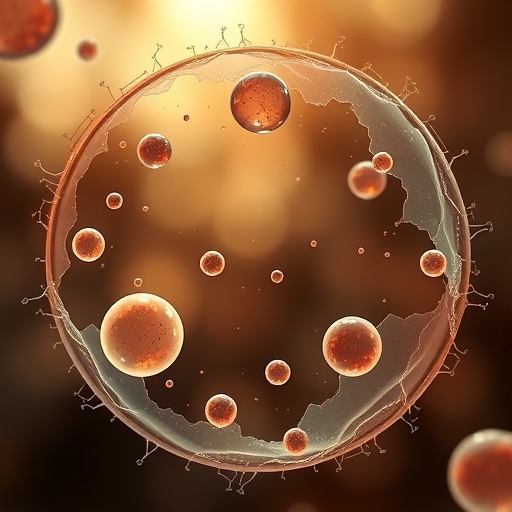Mitochondrial dysfunction has recently emerged as a significant contributor to reproductive challenges, particularly in the realm of female fertility. A groundbreaking study conducted by Wang et al. published in the Journal of Ovarian Research delves into the implications of mitochondrial health in oocytes and its association with age-related fertility decline. As societies grapple with the intertwined issues of advancing maternal age and declining birth rates, this research marks a pivotal moment in understanding how mitochondrial integrity influences both fertility and the aging process in women.
The oocyte, or egg cell, serves as a critical component in human reproduction, reliant on cellular energy generated by mitochondria. Mitochondria, often referred to as the powerhouse of the cell, are responsible for producing the adenosine triphosphate (ATP) necessary for cellular functions. This study emphasizes that as women age, mitochondrial function within oocytes diminishes, potentially leading to reduced fertility and an increased risk of developmental anomalies in offspring. This decline in mitochondrial activity is not merely a trivial aspect of cellular health but is central to the viability of oocytes.
At the heart of this research lies the exploration of how mitochondrial dysfunction can manifest over time, particularly as oocytes undergo processes of maturation. The authors point out that aging is often accompanied by a decline in mitochondrial biogenesis and an increase in oxidative stress, both of which can compromise the functionality of oocytes. Mitochondrial DNA (mtDNA) mutations accumulate with age, further exacerbating this problem. These findings underscore the need for deeper investigations into the cellular mechanisms at play, elucidating how these mitochondria-related deficiencies may pose challenges for conception.
Additionally, the implications of mitochondrial dysfunction extend beyond fertility, as the researchers draw a connection to broader health concerns associated with aging. Infertility rates are rising globally, and understanding the mitochondrial contributions to this phenomenon opens new pathways for innovative treatments. This study sheds light on the critical window of oocyte maturation, suggesting that reparative strategies targeting mitochondrial health could enhance fertility outcomes. Such approaches may not only restore oocyte function but also rejuvenate overall reproductive potential.
The research team’s methodology involved rigorous experimentation on oocyte samples alongside assessments of mitochondrial function parameters. The data collected present a compelling narrative regarding the age-dependent decline of mitochondrial performance. For instance, younger oocytes displayed higher ATP production and improved energy metabolism compared to older counterparts. These observations were consistent across various experimental setups, reinforcing the hypothesis that mitochondrial health is intrinsically linked to oocyte quality and subsequently, female fertility.
Moreover, the study presents significant insights into potential therapeutic interventions aimed at mitigating the adverse effects of mitochondrial dysfunction. The researchers advocate for lifestyle modifications and dietary interventions that could enhance mitochondrial activity. Nutrients such as coenzyme Q10, omega-3 fatty acids, and antioxidants have shown promise in preliminary studies, offering a glimmer of hope for women at risk of age-related fertility challenges. By implementing such strategies, women may optimize their oocyte health and, consequently, their reproductive outcomes.
In light of the findings, the research team calls for a reevaluation of current fertility treatments. Traditional approaches often overlook mitochondrial health as a critical factor in infertility. By considering mitochondrial function as an integral aspect of reproductive health, fertility specialists may provide more tailored and effective interventions. The need for a paradigm shift in how we treat infertility is emphasized, advocating for a holistic approach to women’s reproductive health that incorporates mitochondrial assessments.
As this research gains traction, it invites further inquiry into the correlation between mitochondrial health and fertility across diverse populations. Investigating potential genetic or environmental factors contributing to mitochondrial dysfunction in oocytes could yield valuable information that transcends the current study. For instance, examining lifestyle choices, exposure to toxins, and nutritional habits could provide a more comprehensive understanding of how these variables influence mitochondrial integrity in reproductive cells.
This study also brings to the forefront the need for raising public awareness about age-related fertility issues. As societal norms shift, and more women delay childbirth for education and career pursuits, the dialogue surrounding reproductive health must evolve. Educating women about the vital role of mitochondria could empower them to make informed choices regarding their reproductive lives. Additionally, public health campaigns targeting mitochondrial health could serve as proactive measures in addressing the fertility crisis facing many modern societies.
In conclusion, Wang et al.’s research marks an important contribution to the understanding of mitochondrial dysfunction in oocytes and its far-reaching implications for fertility and aging. The intricate relationship between mitochondrial health and reproductive capacity underscores a critical area in reproductive biology that demands further exploration. As scientists continue to unravel the complexities of female fertility, targeting mitochondrial dysfunction could pave the way for innovative strategies aimed at enhancing reproductive health across generations.
As we look forward, the intersection between mitochondrial research and reproductive medicine holds the potential to reshape the landscapes of fertility treatments. This study serves as a cornerstone for future investigations, laying the groundwork for a deeper understanding of how we can harness the power of mitochondria to address one of the most pressing issues facing women today. From bench to bedside, the exploration of mitochondrial dysfunction in oocytes is sure to spark discussions and research initiatives aimed at safeguarding fertility in women worldwide.
Subject of Research: Mitochondrial dysfunction in oocytes and its implications for fertility and aging.
Article Title: Mitochondrial dysfunction in oocytes: implications for fertility and ageing.
Article References:
Wang, T., Xu, P., Yuan, J. et al. Mitochondrial dysfunction in oocytes: implications for fertility and ageing.
J Ovarian Res 18, 186 (2025). https://doi.org/10.1186/s13048-025-01764-6
Image Credits: AI Generated
DOI: 10.1186/s13048-025-01764-6
Keywords: Mitochondrial dysfunction, oocytes, female fertility, aging, reproductive health.




